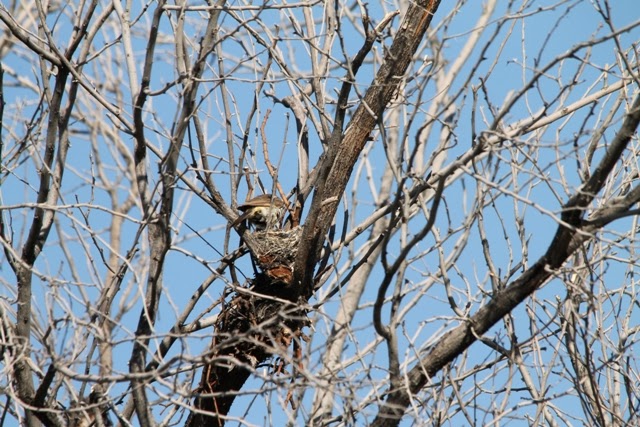I was tagging photos last month, and realized I had a fair number of Vermilion Flycatcher nests, so I thought I’d share them: (1) because they’re interesting, and (2) because I figured they may help folks develop their own search image! Sadly, I had some great ones a few years back, but the camera they were on fell into the Walker River before I’d had a chance to download them. (And yes, I now clip my phone to its case – and the case to me – just to prevent this sort of thing from happening again! Lesson learned.)
All of these photos were taken by me at Warm Springs Natural Area, except for one by Amy Leist down along the Lower Colorado River (thanks Amy!). Of the pictures at Warm Springs, only one nest (2 pictures) is from prior to the 2010 fire (again, see The Walker River Incident), and most are from 2012-2013. Interestingly, the fire didn’t seem to impact the Vermilion nesting as much as expected (at least on a short-term basis): as you can see, the majority of these nest photos are within burned and leafless screwbean mesquites and cottonwoods. This may be because, even prior to the fire, they typically began nesting early while the screwbeans lacked leaves, anyway. Depending on the photo, it may not be obvious, but the nests were shaded for significant portions of the day. The exception was a nest in 2012, which was fairly high up in a burned tree, and did not have that shading – the female there ended up spending a lot of time acting as an parasol!
Based on their Birds of North America account [1], the most important nest trees include willows, cottonwoods, and mesquites. As I mentioned, at Warm Springs, they appear most frequently in the cottonwood/screwbean mesquite habitats, but also use honey mesquite. In the literature, honey mesquite appears more frequently than screwbeans, which is unsurprising given it has a much larger range.
Nests are typically located 2-6m, and up to 18m, off the ground, though this depends greatly on the kind of habitat they’re in – nests in cottonwood habitats are understandably much more apt to be higher than those in shorter mesquite stands.
This first photo was taken in 2009 – you’ll have to squint to find the nest, but you can see some fine nest material on the top of the branch – the nest itself has been constructed within a forked branch. In the next photo, the black arrow points to the nest location relative to the screwbean plant itself. This stand had large numbers of Vermilions in it, and was a fairly open screwbean mesquite stand with scattered honey mesquites and quailbush, and (often) a dense carpet of grass.
 Here’s another photo of a nest within a screwbean mesquite. As you can see, this mesquite hasn’t yet begun to leaf out significantly. Unfortunately, I don’t have a photo of the nest location relative to the rest of the plant, but the nest was a little under 6 feet high, and probably just under half the height of the mesquite it was in. Again, the nest is in the fork of a branch.
Here’s another photo of a nest within a screwbean mesquite. As you can see, this mesquite hasn’t yet begun to leaf out significantly. Unfortunately, I don’t have a photo of the nest location relative to the rest of the plant, but the nest was a little under 6 feet high, and probably just under half the height of the mesquite it was in. Again, the nest is in the fork of a branch.
And another nest within a screwbean mesquite. Again, the nest is constructed within a fork, and was approximately 6 feet high.
 Moving on, here we have a nest in what I believe is a dead (burned) ash, and a landscape photo – you can see the dead branches from the “ash” in the center of the photo (background). I evidently didn’t write down the height of this nest, but it was probably about 7 feet high (it was well over my head). (**) This was taken in 2013.
Moving on, here we have a nest in what I believe is a dead (burned) ash, and a landscape photo – you can see the dead branches from the “ash” in the center of the photo (background). I evidently didn’t write down the height of this nest, but it was probably about 7 feet high (it was well over my head). (**) This was taken in 2013.
The next two photos were taken in 2012 and 2013, in another scorched ash – though in 2012, it still had some leaves. As you can tell, they refurbished the same nest location! A third photo, with the arrow, shows the nest location relative to the rest of the tree.
 |
| Vermilion Flycatcher nest, 2012 |
 |
| Vermilion Flycatcher nest, 2013 |
This pic, taken in 2012, may be in another burned screwbean (it’s a mesquite, at any rate), and is the one I mentioned earlier, that did not have shade … you can see the female standing on the nest’s edge in the photo. This may be the same pair that is starred (**) above. At any rate, this location is very close to that above.
 |
| Add caption |
The next several photos are of nests within burned cottonwoods. Some of these appear to be built within forks, others do not (or at least it is not obvious); all are on fairly flat sections of the branch, and are shaded by branches above and beside them.
Anyway, that’s it for now! Happy birding,
-- Jen
[1] Ellison, Kevin, Blair O. Wolf and Stephanie L. Jones. 2009. Vermilion Flycatcher (Pyrocephalus rubinus), The Birds of North America Online (A. Poole, Ed.). Ithaca: Cornell Lab of Ornithology; Retrieved from the Birds of North America Online: http://bna.birds.cornell.edu/bna/species/484









No comments:
Post a Comment